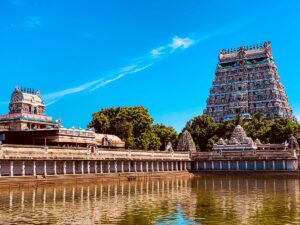The Best Kumbakonam Taxi Service Packages for Navagraha Tours
The Best Kumbakonam Taxi Service Packages for Navagraha Tours
Kumbakonam, often referred to as the “Temple Town,” is a place brimming with ancient temples, rich cultural heritage, and spiritual significance. Located in Tamil Nadu, this historic town attracts tourists and pilgrims from all over the world. Whether you’re visiting Kumbakonam for its temples, cultural experiences, or nearby attractions, traveling in a group offers a unique way to bond, explore, and make memories together. Kumbakonam Taxi Service Packages for Group Travelers make your journey more comfortable, convenient, and enjoyable, ensuring a hassle-free travel experience. The Best Kumbakonam Taxi Service Packages for Navagraha Tours

In this article, we will discuss the various Kumbakonam taxi service packages specifically designed for group travelers, highlighting the benefits, features, and why these packages are perfect for your next group trip.
1. Why Choose Kumbakonam Taxi Service for Group Travel?
Traveling in a group can often be a challenge, especially when it comes to transportation. Whether you’re with family, friends, or a group of pilgrims, coordinating the movement of a large group can be cumbersome. Kumbakonam taxi services cater specifically to group travel, offering a smooth, coordinated experience. Here’s why choosing a Kumbakonam taxi service for your group tour is the best option:
- Comfort and Convenience: With spacious and well-maintained vehicles, you won’t have to worry about seating arrangements or comfort. Group taxi services offer vehicles that can accommodate 5, 10, or even larger groups, ensuring everyone travels together without any hassle.
- Cost-Effective: Group travel can often become expensive when using individual taxis or separate vehicles. Kumbakonam taxi services offer affordable packages tailored for groups, providing great value without compromising on comfort.
- Experienced Drivers: Kumbakonam taxi services employ local, experienced drivers who are well-versed with the area and routes. Their knowledge ensures that you travel safely and efficiently, while also providing insights into local attractions, temples, and historical landmarks.
- Customized Itineraries: Taxi services in Kumbakonam offer flexible packages that can be customized based on your group’s preferences. Whether you wish to explore local temples, visit nearby towns, or take a scenic drive, your itinerary can be tailored to suit your group’s interests and time constraints.
2. Popular Kumbakonam Taxi Packages for Group Travelers
Kumbakonam offers several taxi packages, both for local tours and outstation tours, that are ideal for group travelers. Here are some popular options:
a. Kumbakonam Local Temple Tour Package
Kumbakonam is home to some of the most significant temples in Tamil Nadu. The Kumbakonam Local Temple Tour Package is an excellent choice for groups looking to explore the rich spiritual heritage of the region. Some of the must-visit temples included in this package are:
- Brihadeeswarar Temple: A UNESCO World Heritage Site and one of the largest temples in India, dedicated to Lord Shiva.
- Airavatesvara Temple: A beautiful and ancient temple dedicated to Lord Shiva, known for its stunning architecture.
- Adi Kumbeswarar Temple: A key temple in Kumbakonam, dedicated to Lord Shiva, and one of the oldest in the region.
- Kumbakonam Brahma Temple: A unique temple dedicated to Lord Brahma, the creator in Hindu mythology.
This local tour package is perfect for groups of pilgrims, families, and religious tour enthusiasts. It allows you to visit multiple temples in a single day with convenient transportation and a dedicated driver to guide you.
b. Kumbakonam and Surrounding Temples Tour Package
For larger groups wishing to explore Kumbakonam and its surrounding regions, the Kumbakonam and Surrounding Temples Tour Package is an excellent option. This extended tour includes visits to nearby temples and destinations such as:
- Tiruvidaimarudur: A prominent Shiva temple.
- Thanjavur: Famous for the Brihadeeswarar Temple and the Maratha palace.
- Swamimalai: A revered temple for Lord Murugan, with breathtaking views of the surrounding area.
This tour package is ideal for groups that have more time to explore the area’s vast spiritual and cultural heritage.
c. Outstation Group Tour Packages
Kumbakonam’s location makes it an ideal starting point for exploring nearby towns and regions. Kumbakonam taxi services offer outstation tour packages that take you beyond the temples of the town, allowing you to explore the beauty of Tamil Nadu and nearby states.
- Rameswaram: A sacred destination for Hindu pilgrims, known for its Rameswaram Temple and the Pamban Bridge.
- Madurai: Known for the Meenakshi Amman Temple, Madurai is a cultural hub with ancient architecture and spiritual significance.
- Chidambaram: Famous for the Nataraja Temple, dedicated to Lord Shiva in his dancing form.
- Kanyakumari: The southernmost tip of India, known for its scenic beauty and the Vivekananda Rock Memorial.
Outstation taxi packages are an ideal choice for groups wishing to explore multiple destinations in one trip. With affordable pricing and group-friendly options, these tours are designed to provide comfort and convenience while covering several must-see locations.
d. Group Pilgrimage Tour Package
For groups specifically visiting Kumbakonam and surrounding towns for religious purposes, the Group Pilgrimage Tour Package is an excellent choice. This package includes visits to key religious sites and temples, with the added benefit of a structured itinerary that accommodates group schedules. It may also include guided temple tours, ensuring a deeper understanding of the cultural and historical significance of each site.
3. What to Expect from Kumbakonam Taxi Service for Group Travelers
When booking a Kumbakonam taxi service package for a group, you can expect the following features:
- Comfortable Vehicles: Depending on the size of your group, vehicles may range from SUVs, mini-buses, to large buses. The vehicles are air-conditioned, spacious, and equipped with comfortable seating for long journeys.
- Flexible Pickup and Drop-off: Taxi services in Kumbakonam offer flexible pickup and drop-off options, whether from your hotel, temple, or other desired locations.
- Experienced Tour Guides (Optional): For those interested in learning more about the temples and destinations, many packages offer experienced tour guides who provide detailed insights into the history, architecture, and spiritual significance of each site.
- 24/7 Availability: Whether you’re planning a day trip or an extended multi-day tour, Kumbakonam taxi services are available round the clock to accommodate your schedule.
- Group Discounts: Many taxi services offer group discounts, making these packages more affordable for families, friends, or organized religious groups.
4. How to Book Kumbakonam Taxi Service Packages for Group Travelers
Booking a taxi service for group travel in Kumbakonam is simple and convenient. Most services offer online booking, allowing you to:
- Select your desired package (local, outstation, or pilgrimage).
- Choose your travel dates and preferred vehicle.
- Make secure payments online or in person.
- Receive instant booking confirmation and itinerary details.
5. Final Thoughts
Kumbakonam is a spiritual and cultural treasure trove, and the best way to explore it with a group is through a Kumbakonam taxi service. Whether you’re visiting temples in the local area, exploring nearby towns, or embarking on an outstation pilgrimage, these tailored taxi packages offer the perfect solution for group travel. With comfortable vehicles, experienced drivers, and affordable rates, Kumbakonam taxi services ensure that your group trip is memorable, convenient, and filled with spiritual fulfillment.
So, gather your family, friends, or fellow pilgrims and book your Kumbakonam taxi service package today for an unforgettable journey through one of India’s most sacred regions!








